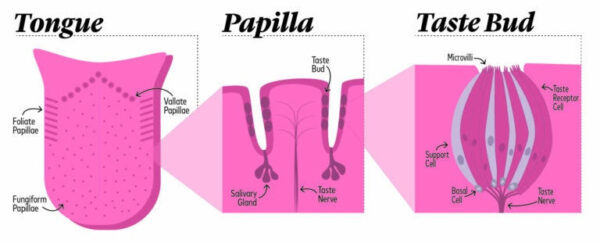October 13, 2023

By: AEOP Membership Council Member Spoorthy Reddy
As the weather turns colder, one thing I love to do is bundle up in my room with a book and a cup of hot chocolate. But how do I tell if my hot chocolate is sweet enough or if it needs more marshmallows? How can I distinguish between its sweetness and the sourness of a lemon? To answer these questions, we’ll have to look deeper into how our sense of taste works.
Well, we all know that we can taste things thanks to our taste buds. But what exactly is a taste bud, and how does it work?
A taste bud has a circular shape and is responsible for sending information about the taste of what you eat to your brain. Your mouth can contain thousands of taste buds. If you look at your tongue in the mirror, you’ll notice that it is dotted with many tiny bumps. These bumps are called papillae, but don’t mistake them for taste buds just yet. Papillae actually contain groups of taste buds, and there are four main types of them. Three of them are found on the tongue. Fungiform papillae are located at the top and sides of the tongue and usually only contain one taste bud each. Foliate papillae are on the folds on the sides of the tongue, while vallate papillae are positioned near the back of the tongue. Both of these papillae can contain up to 250 taste buds each. The fourth type, filiform papillae, is the most numerous but does not contain any taste buds. However, they do contain fine hairs that allow you to feel the texture of what you are eating. The papillae differ in structure but typically have crevices where the taste buds are located. These crevices collect broken down food, allowing the taste buds to taste that food.

The taste buds analyze small bits of the food you consume and categorize them into five main categories: salty, sour, bitter, sweet, and umami. The term umami is a Japanese term that means savory. You might be wondering why these specific categories were chosen. And no, it’s not because they can all be found in your favorite meal. There is an evolutionary advantage to detecting these tastes. Being able to detect sourness and saltiness allows the body to maintain a proper salt and acid balance. Bitterness can serve as a warning of poisonous food, as many poisonous substances produced by plants are bitter. Sweetness and umami can be indicators of calorie-rich and protein-rich foods, respectively. After tasting something, the body needs to decide whether to continue eating or not, and it bases this decision on the taste of the food.
But how does the information get processed and sent to the brain? To answer this question, let’s delve into a bit of anatomy. There are two types of taste bud cells involved in sending taste information to the brain: type II and type III taste bud cells. Type II cells act as receptor cells that detect sweet, bitter, and umami tastes. Type III cells are presynaptic cells. The receptor cells transmit their signals to presynaptic cells, allowing them to process multiple taste signals. The information is then transmitted through a nerve and to the brain. To think there’s so much that goes into enjoying hot chocolate – the human body is indeed fascinating.
Sources:
https://www.popsci.com/story/health/tastebuds-tongue-eating-flavor/?amp
https://www.nature.com/articles/nrn.2017.68
https://www.jneurosci.org/content/27/40/10840.short
https://journals.plos.org/plosbiology/article?id=10.1371/journal.pbio.0020064
Find a Volunteering Opportunity
Visit our Program Volunteers page for a tool to find the best opportunity for you.
eCYBERMISSION Mini-Grant
The eCYBERMISSION Mini-Grant is intended to support teachers/program leaders as they implement eCYBERMISSION with their teams. Educators (formal and informal) of students in grades 6-9 are encouraged to apply.
